Thursday, October 14, 2021
RAMAC
In 1957 IBM's RAMAC system brought together a number of trends and patterns into a new EQUIPMENT.
Trend 1:
Ramac was the first EQUIPMENT for business. In military procurement an equipment is a complete system including all parts necessary. An equipment for pigeoneers included a mobile loft, a prefab stationary loft, cages, feeding dishes, and pigeons. An equipment for aircraft radio included the transmitter and receiver in the aircraft, the transmitter and receiver on the ground, and all necessary wires and microphones and earphones and dynamotors and batteries and antennas.
IBM had been producing individual machines for business (hence the name) since 1890, but hadn't made an equipment before. RAMAC was designed from end to end for the needs of accounting, not for any other skill or department. The acronym was Random Access Method of Accounting and Control.
The M was a little tricky, and the AC was a pun of sorts. M originally stood for Memory, but some other company had the trademark, so M had to be Method. AC habitually stood for Automatic Computer in the usual acronyms, so the name was recognizable as meaning an Automatic Computer even though it 'really' meant Accounting and Control. And it was explicitly for accounting:
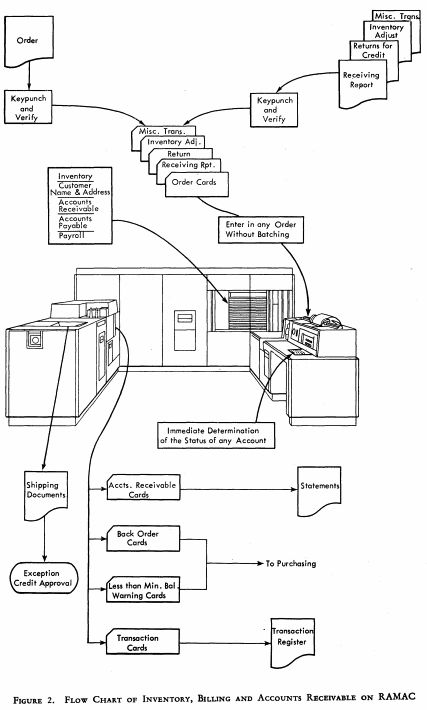 Note that the input and output were IBM's default cards. The system included at least one memory drum, which was an established machine at the time, and several magnetic memory matrices. Those weren't the New and Improved part. Reynold Johnson's multiple disk was the iconic part of RAMAC.
= = = = =
Trend 2:
Recording and storing sound and data have mostly taken separate paths, occasionally converging and then diverging again.
Recording and storing DATA has gone through three stages.
Tape, cylinder, disk.
Cards are a subset of tape. Jacquard stored programs on a chained set of metal cards, essentially a jointed tape. Early telegraph systems used punched tape, and computers continued the form well into the 1970s.
Hollerith established free-standing cards as the default physical data holder for computers in 1890.
Magnetic recording began with Valdemar Poulsen, primarily responsible for the wire recorder. Poulsen also tried a magnetic disk, similar in size and shape to the RAMAC disks.
Note that the input and output were IBM's default cards. The system included at least one memory drum, which was an established machine at the time, and several magnetic memory matrices. Those weren't the New and Improved part. Reynold Johnson's multiple disk was the iconic part of RAMAC.
= = = = =
Trend 2:
Recording and storing sound and data have mostly taken separate paths, occasionally converging and then diverging again.
Recording and storing DATA has gone through three stages.
Tape, cylinder, disk.
Cards are a subset of tape. Jacquard stored programs on a chained set of metal cards, essentially a jointed tape. Early telegraph systems used punched tape, and computers continued the form well into the 1970s.
Hollerith established free-standing cards as the default physical data holder for computers in 1890.
Magnetic recording began with Valdemar Poulsen, primarily responsible for the wire recorder. Poulsen also tried a magnetic disk, similar in size and shape to the RAMAC disks.
 Wire started widening into tape around 1940, as plastic manufacturing matured. Wire was never used for data, but magnetic tape quickly became the standard for internal storage of data, with cards as the human-readable inputs and outputs.
= = = = =
Trend 3:
Reynold Johnson joined IBM in the '30s and brought the world of analog thinking and sense transducing into the mechanistic and digital world of sorters and collators. Johnson's team was responsible for the multiple hard disk that formed the unique center of RAMAC.
= = = = =
IBM threw a nationwide party to introduce RAMAC, with showings in major cities, following GM's
Motorama trend.
Wire started widening into tape around 1940, as plastic manufacturing matured. Wire was never used for data, but magnetic tape quickly became the standard for internal storage of data, with cards as the human-readable inputs and outputs.
= = = = =
Trend 3:
Reynold Johnson joined IBM in the '30s and brought the world of analog thinking and sense transducing into the mechanistic and digital world of sorters and collators. Johnson's team was responsible for the multiple hard disk that formed the unique center of RAMAC.
= = = = =
IBM threw a nationwide party to introduce RAMAC, with showings in major cities, following GM's
Motorama trend.
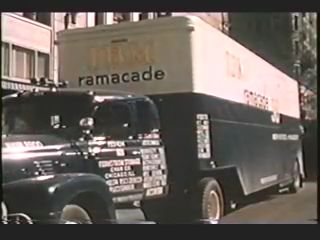 Again the name had to be slightly offbase. Ramarama wouldn't do.
Later, RAMAC served to keep score at the 1960 winter Olympics, with more hoopla.
Again the name had to be slightly offbase. Ramarama wouldn't do.
Later, RAMAC served to keep score at the 1960 winter Olympics, with more hoopla.

 Note the lack of OCD. Smoking and eating around the computer were EXPECTED. Machines and humans were both designed to tolerate normal life.
= = = = =
As an Equipment, RAMAC was meant to be set up in exactly one configuration, and IBM provided all necessary cabling to set it up.
Proper setup:
Note the lack of OCD. Smoking and eating around the computer were EXPECTED. Machines and humans were both designed to tolerate normal life.
= = = = =
As an Equipment, RAMAC was meant to be set up in exactly one configuration, and IBM provided all necessary cabling to set it up.
Proper setup:
 The floor plan with exact measurements:
The floor plan with exact measurements:
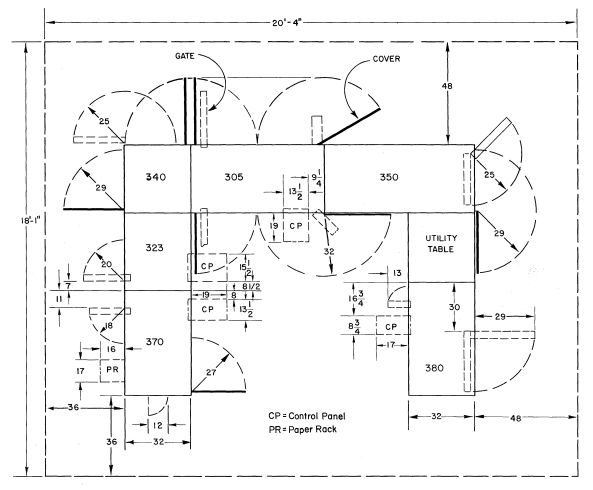 = = = = =
Now my version, demonstrated as usual by Polistra and Happystar.
= = = = =
Now my version, demonstrated as usual by Polistra and Happystar.
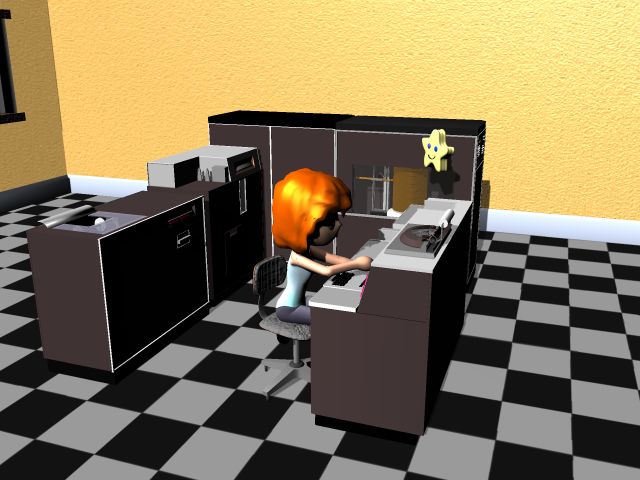
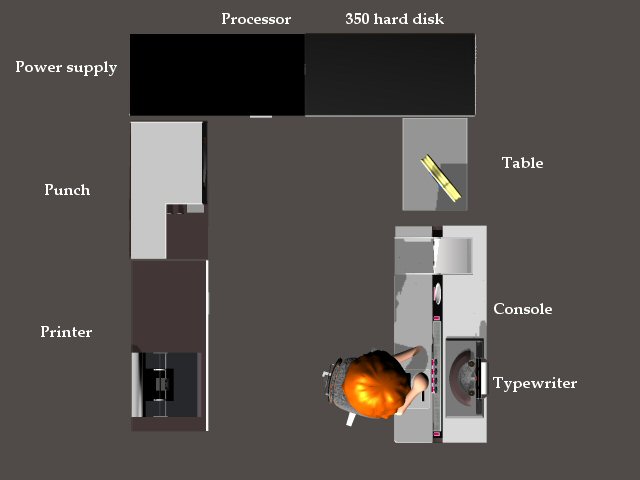 Unlike the other memory devices, the 350 hard disk had a glass front. Ramarama again.
Unlike the other memory devices, the 350 hard disk had a glass front. Ramarama again.
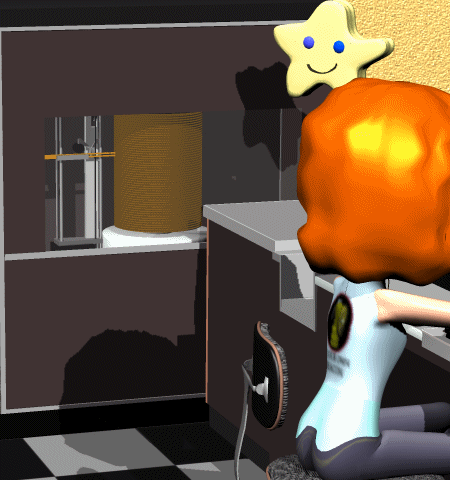 It was sometimes called the Jukebox Memory for obvious reasons. Each disk was coated on both sides, and the arm traveled radially in and out to reach any point on any of the 50 disks in a few milliseconds. The up/down and in/out movements were both driven by servomotors. Up/down was on a pulley, and in/out was a rack and pinion. The base of the 305 box included an air compressor, with hoses to each head to maintain spacing from the surface.
It was sometimes called the Jukebox Memory for obvious reasons. Each disk was coated on both sides, and the arm traveled radially in and out to reach any point on any of the 50 disks in a few milliseconds. The up/down and in/out movements were both driven by servomotors. Up/down was on a pulley, and in/out was a rack and pinion. The base of the 305 box included an air compressor, with hoses to each head to maintain spacing from the surface.
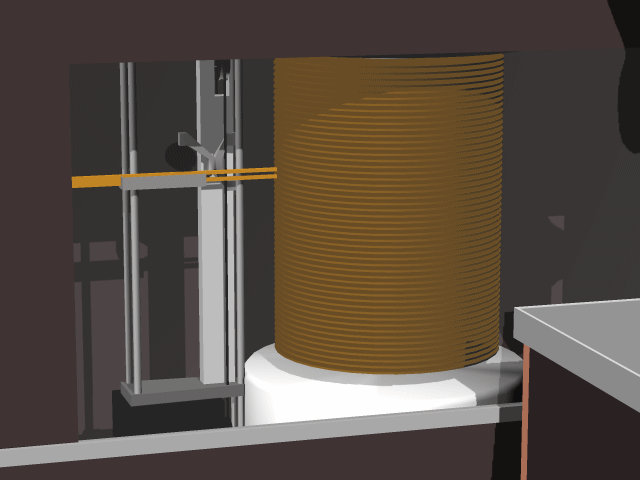 Other parts of the system were older technologies, mainly using cards.
Each machine had at least one internal plugboard, continuing the programming technique that began with Hollerith's first 1880 census tabulator:
Other parts of the system were older technologies, mainly using cards.
Each machine had at least one internal plugboard, continuing the programming technique that began with Hollerith's first 1880 census tabulator:
 A fast printer was available:
A fast printer was available:
 The console at right had a card reader:
The console at right had a card reader:
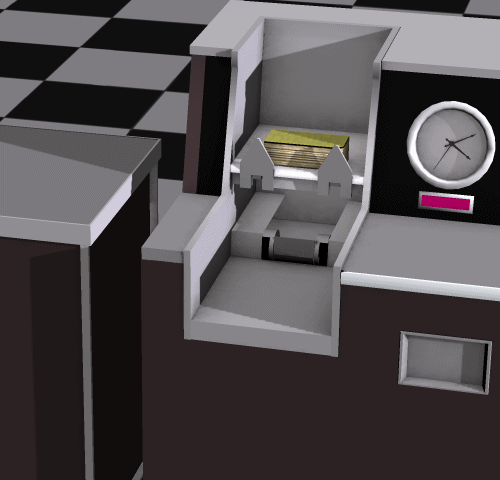 And a conventional typewriter for output in more readable form:
And a conventional typewriter for output in more readable form:
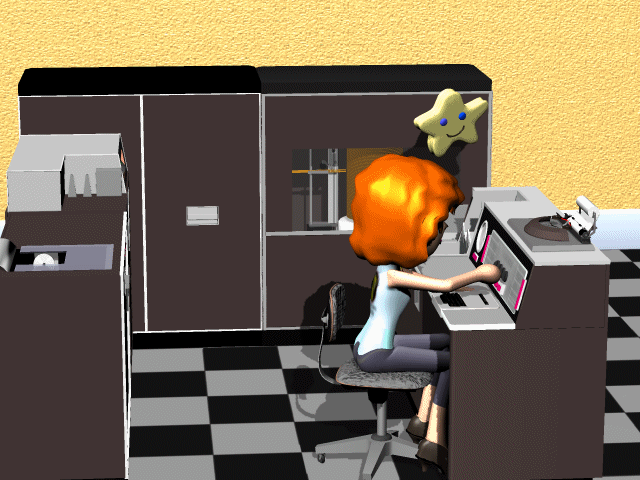 Only a few thousand RAMACs were installed, but they changed the landscape of computing.
= = = = =
Footnote: Credit to Ed Thelen's RAMAC site for most of the necessary information.
Only a few thousand RAMACs were installed, but they changed the landscape of computing.
= = = = =
Footnote: Credit to Ed Thelen's RAMAC site for most of the necessary information.
 Note that the input and output were IBM's default cards. The system included at least one memory drum, which was an established machine at the time, and several magnetic memory matrices. Those weren't the New and Improved part. Reynold Johnson's multiple disk was the iconic part of RAMAC.
= = = = =
Trend 2:
Recording and storing sound and data have mostly taken separate paths, occasionally converging and then diverging again.
Recording and storing DATA has gone through three stages.
Tape, cylinder, disk.
Cards are a subset of tape. Jacquard stored programs on a chained set of metal cards, essentially a jointed tape. Early telegraph systems used punched tape, and computers continued the form well into the 1970s.
Hollerith established free-standing cards as the default physical data holder for computers in 1890.
Magnetic recording began with Valdemar Poulsen, primarily responsible for the wire recorder. Poulsen also tried a magnetic disk, similar in size and shape to the RAMAC disks.
Note that the input and output were IBM's default cards. The system included at least one memory drum, which was an established machine at the time, and several magnetic memory matrices. Those weren't the New and Improved part. Reynold Johnson's multiple disk was the iconic part of RAMAC.
= = = = =
Trend 2:
Recording and storing sound and data have mostly taken separate paths, occasionally converging and then diverging again.
Recording and storing DATA has gone through three stages.
Tape, cylinder, disk.
Cards are a subset of tape. Jacquard stored programs on a chained set of metal cards, essentially a jointed tape. Early telegraph systems used punched tape, and computers continued the form well into the 1970s.
Hollerith established free-standing cards as the default physical data holder for computers in 1890.
Magnetic recording began with Valdemar Poulsen, primarily responsible for the wire recorder. Poulsen also tried a magnetic disk, similar in size and shape to the RAMAC disks.
 Wire started widening into tape around 1940, as plastic manufacturing matured. Wire was never used for data, but magnetic tape quickly became the standard for internal storage of data, with cards as the human-readable inputs and outputs.
= = = = =
Trend 3:
Reynold Johnson joined IBM in the '30s and brought the world of analog thinking and sense transducing into the mechanistic and digital world of sorters and collators. Johnson's team was responsible for the multiple hard disk that formed the unique center of RAMAC.
= = = = =
IBM threw a nationwide party to introduce RAMAC, with showings in major cities, following GM's
Motorama trend.
Wire started widening into tape around 1940, as plastic manufacturing matured. Wire was never used for data, but magnetic tape quickly became the standard for internal storage of data, with cards as the human-readable inputs and outputs.
= = = = =
Trend 3:
Reynold Johnson joined IBM in the '30s and brought the world of analog thinking and sense transducing into the mechanistic and digital world of sorters and collators. Johnson's team was responsible for the multiple hard disk that formed the unique center of RAMAC.
= = = = =
IBM threw a nationwide party to introduce RAMAC, with showings in major cities, following GM's
Motorama trend.
 Again the name had to be slightly offbase. Ramarama wouldn't do.
Later, RAMAC served to keep score at the 1960 winter Olympics, with more hoopla.
Again the name had to be slightly offbase. Ramarama wouldn't do.
Later, RAMAC served to keep score at the 1960 winter Olympics, with more hoopla.

 Note the lack of OCD. Smoking and eating around the computer were EXPECTED. Machines and humans were both designed to tolerate normal life.
= = = = =
As an Equipment, RAMAC was meant to be set up in exactly one configuration, and IBM provided all necessary cabling to set it up.
Proper setup:
Note the lack of OCD. Smoking and eating around the computer were EXPECTED. Machines and humans were both designed to tolerate normal life.
= = = = =
As an Equipment, RAMAC was meant to be set up in exactly one configuration, and IBM provided all necessary cabling to set it up.
Proper setup:
 The floor plan with exact measurements:
The floor plan with exact measurements:
 = = = = =
Now my version, demonstrated as usual by Polistra and Happystar.
= = = = =
Now my version, demonstrated as usual by Polistra and Happystar.

 Unlike the other memory devices, the 350 hard disk had a glass front. Ramarama again.
Unlike the other memory devices, the 350 hard disk had a glass front. Ramarama again.
 It was sometimes called the Jukebox Memory for obvious reasons. Each disk was coated on both sides, and the arm traveled radially in and out to reach any point on any of the 50 disks in a few milliseconds. The up/down and in/out movements were both driven by servomotors. Up/down was on a pulley, and in/out was a rack and pinion. The base of the 305 box included an air compressor, with hoses to each head to maintain spacing from the surface.
It was sometimes called the Jukebox Memory for obvious reasons. Each disk was coated on both sides, and the arm traveled radially in and out to reach any point on any of the 50 disks in a few milliseconds. The up/down and in/out movements were both driven by servomotors. Up/down was on a pulley, and in/out was a rack and pinion. The base of the 305 box included an air compressor, with hoses to each head to maintain spacing from the surface.
 Other parts of the system were older technologies, mainly using cards.
Each machine had at least one internal plugboard, continuing the programming technique that began with Hollerith's first 1880 census tabulator:
Other parts of the system were older technologies, mainly using cards.
Each machine had at least one internal plugboard, continuing the programming technique that began with Hollerith's first 1880 census tabulator:
 A fast printer was available:
A fast printer was available:
 The console at right had a card reader:
The console at right had a card reader:
 And a conventional typewriter for output in more readable form:
And a conventional typewriter for output in more readable form:
 Only a few thousand RAMACs were installed, but they changed the landscape of computing.
= = = = =
Footnote: Credit to Ed Thelen's RAMAC site for most of the necessary information.
Only a few thousand RAMACs were installed, but they changed the landscape of computing.
= = = = =
Footnote: Credit to Ed Thelen's RAMAC site for most of the necessary information.
Labels: Alternate universe, Equipoise
